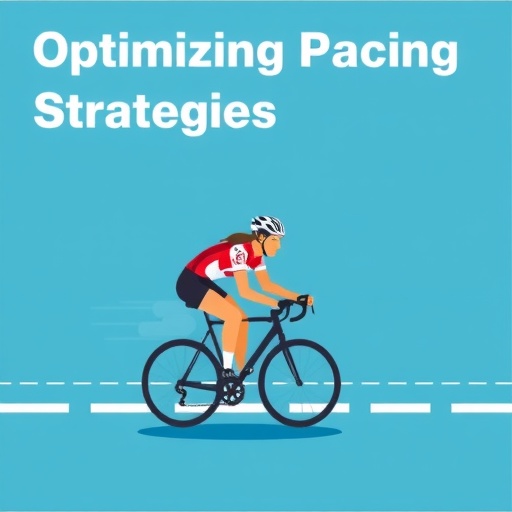In the realm of competitive cycling, the nuances of pacing strategy can dramatically impact an athlete’s performance. A recent study published in the journal Sports Engineering pioneers a comprehensive numerical design methodology aimed at optimizing pacing strategies specifically for individual time trials. This innovative approach addresses the multifaceted nature of endurance events through rigorous algorithmic analysis. The research uncovers how optimal pacing can enhance overall efficiency and outcome in time trials, fundamentally shifting how cyclists approach their training and race execution.
The authors of this study, Bach, Alexandersen, and Lundgaard, delve into the intricacies of physiological responses during prolonged efforts. They emphasize the importance of a well-structured pacing strategy that not only considers the athlete’s peak performance but also accounts for fatigue management throughout the race. This methodology combines mathematical modeling with empirical data to create a tailored pacing strategy that could revolutionize training practices for cyclists at all levels.
A unique aspect of this methodology is its reliance on a comprehensive data-driven framework. The researchers utilized a wealth of performance metrics collected from previous races to inform their algorithms, allowing for precise predictions of energy expenditure and fatigue over time. This analytical approach provides insights into how cyclists can maintain optimal power outputs while modulating their effort in response to real-time feedback.
At the heart of the numerical design lies a sophisticated optimization algorithm capable of simulating various pacing strategies. By inputting individual cyclist data such as VO2 max, lactate thresholds, and race conditions, the algorithm can forecast performance outcomes based on different pacing approaches. This simulation capability allows cyclists and coaches to experiment with various strategies, determining the most effective pacing profile to maximize finishing times.
Moreover, the methodology integrates considerations for race-specific variables that can affect pacing decisions, such as terrain, wind conditions, and even psychological factors. By adapting to these external influences, the algorithm enhances its predictive power, providing cyclists with a tactical edge during competitions. This adaptability is critical, as optimal pacing in a time trial setting may vary significantly between stages of a race and depending on environmental factors.
The researchers also highlight the significance of recovery dynamics in their analysis. A critical finding from their work is that inappropriate pacing can lead to an earlier onset of fatigue, adversely affecting performance. Balancing high-intensity efforts with periods of active recovery is vital for maintaining overall power output throughout the time trial. This insight encourages cyclists to rethink traditional racing tactics that may prioritize sustained high speeds without adequate recovery.
Furthermore, the application of this numerical design methodology extends beyond elite athletes to include amateur cyclists who seek to enhance their performance. By democratizing access to advanced pacing strategies, the study offers tools and frameworks that can significantly improve training outcomes for cyclists at all skill levels. The implications of this research could lead to a broader cultural shift in how cyclists approach their training regimens and competition strategies.
As the cycling community begins to adopt these cutting-edge techniques, the potential for improved race times and athletic performance appears limitless. The authors are optimistic that their findings will inspire further research into personalized performance enhancement strategies across various endurance and power-based sports. Their work introduces a paradigm shift in understanding how a data-driven approach can refine athletic performance by meticulously managing pacing through predictive modeling.
In conclusion, this groundbreaking research provides a robust foundation for optimizing pacing strategy in individual time trials. By employing a numerical design methodology that integrates comprehensive data analysis, physiological insights, and real-time feedback, the study equips cyclists with the tools necessary to elevate their performance to new heights. The ongoing evolution of sports science continues to unveil innovative strategies that empower athletes to realize their fullest potential, marking a new era in competitive cycling.
With the introduction of these advanced methodologies, coaches and athletes alike are poised to harness the power of mathematical modeling to refine their approach to racing. Future competitions may witness a refinement of tactics that can lead to unprecedented performances, raising the stakes in an already highly competitive sport. The lasting impact of this research will undoubtedly ripple through the cycling world, encouraging a continued emphasis on evidence-based training practices.
As more athletes embrace this new paradigm, the quest for enhanced performance through pace optimization is set to gain momentum. This study not only enhances our understanding of endurance racing but also illustrates the profound impact of science and technology on sports performance. The shift towards data-driven decision-making paves the way for a new generation of cyclists who will compete with greater precision, strategy, and foresight.
Subject of Research: Optimal pacing strategies in individual time trials for cycling.
Article Title: Correction: A numerical design methodology for optimal pacing strategy in the individual time trial discipline of cycling.
Article References:
Bach, A.F., Alexandersen, J. & Lundgaard, C.B. Correction: A numerical design methodology for optimal pacing strategy in the individual time trial discipline of cycling.
Sports Eng 28, 20 (2025). https://doi.org/10.1007/s12283-025-00500-z
Image Credits: AI Generated
DOI: Not provided.
Keywords: Cycling, Pacing Strategy, Time Trial, Performance Optimization, Sports Engineering, Endurance Training, Data Analysis, Mathematical Modeling, Fatigue Management.




